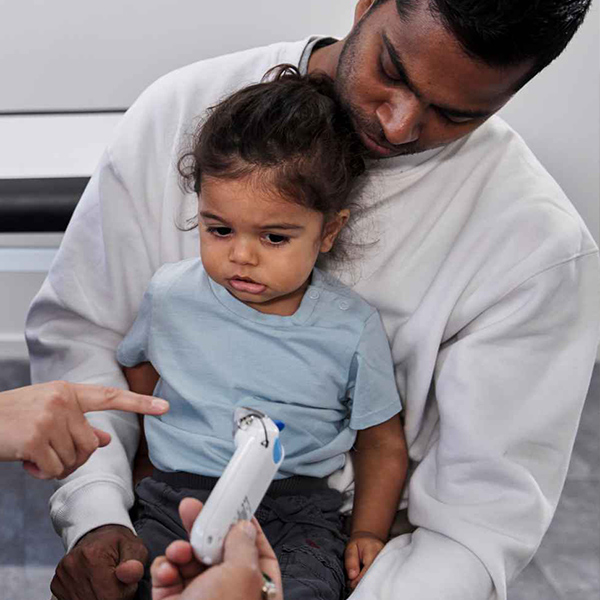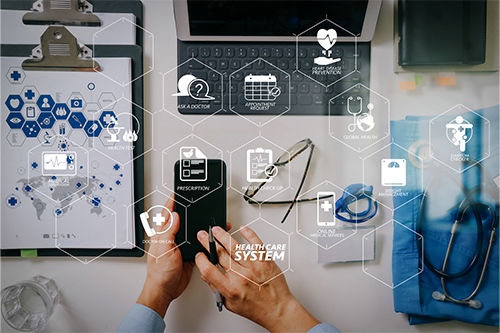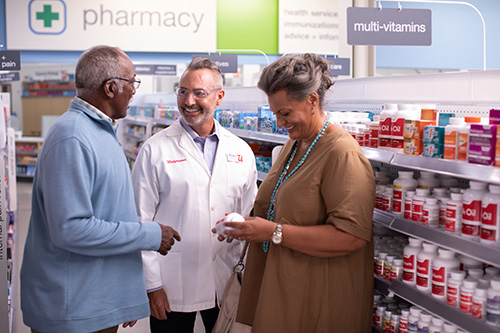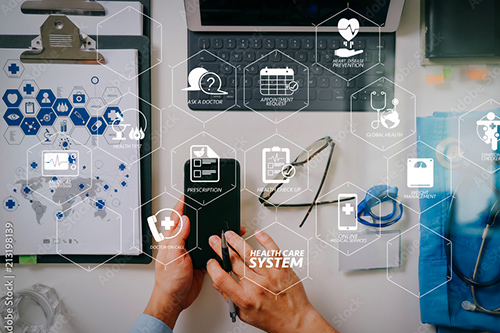Health Equity
The high cost of health disparities—why it matters to Walgreens Health and should matter to you
Social responsibility is our business at Walgreens Boots Alliance (WBA). It’s what we do and why we exist. As an integrated healthcare, pharmacy and retail leader serving millions of customers and patients every day, our pharmacists and pharmacy teams are playing a greater role in healthcare than ever before.
Given our size and nationwide reach, we have both the ability and responsibility to serve a leading role in addressing inequities in healthcare. Walgreens has been committed to advancing health equity for years—with campaigns around flu, pediatric diabetes, asthma, HIV, and other conditions.
In 2021, WBA doubled down on this priority focus, with a new vision to be the leading partner in reimagining local healthcare and well-being for all.
We believe that advancing health equity represents critical integration points connecting each of our distinct business units to drive impact for our communities.
Achieving health equity is in everyone’s interest, and improving health outcomes for all patients, especially those in underserved populations, is essential to the overall health of our communities.
With the heightened focus in the healthcare industry on health equity, it’s vital for organizations to understand, and commit to achieving health equity. It’s a win-win for all organizations and underserved communities because actively supporting health equity can help increase satisfaction and retention while improving outcomes to help lower costs and serve as a catalyst for better services in underserved communities.
Understanding the barriers
Research has proven that social determinants of health (SDOH), the nonmedical factors that influence health outcomes, play an important underlying role in health disparities.
SDOH include the conditions in which people are born, grow up, live, work and age.1 These are affected by the distribution of money, power and resources at global, national and local levels, including:2
- Healthcare access and quality
- Education access and quality
- Social and community context
- Economic stability
- Neighborhood and built environment
SDOH can drive as much as 80% of health outcomes,3 with people of color facing higher rates of diabetes, obesity, stroke, heart disease and cancer than white patients.4
~18% of US GDP
was spent on healthcare in 20197
$309 billion
is the estimated annual cost resulting from healthcare disparities8
~18% of US GDP
was spent on healthcare in 2019
$309 billion
is the estimated annual cost resulting from healthcare disparities

Health equity and COVID-19
The COVID-19 pandemic serves as a stark proof point of the devastation health disparities can cause. Racial and ethnic minorities in our country experience a disproportionate burden of preventable disease, death and disability as compared with nonminorities.5 And long-standing systemic health and social inequalities have put racial and ethnic minority groups at greater risk from getting sick and dying from COVID-19.6
Listen-and-learn act
The pandemic and the social justice movement of 2020 underlined the urgency to address health disparities. The broad WBA organization implemented a listen-and-learn-act model. This model implemented the critical steps of listening to our communities, hearing their needs, and then exploring these areas proactively while leveraging the opportunity to close healthcare gaps.
Chicago Health Equity Incubator
Breaking through those barriers is the core mission of the Chicago Health Equity Pilot. This community-focused program is designed to address health disparities and improve health outcomes in neighborhoods on Chicago’s South and West Side through pharmacy and healthcare services. The program officially launched in August 2020, using predictive analytical models. In June 2022, interventions were launched to support medication adherence and mental health conditions.
COVID-19 Vaccine Equity Initiative
This national, cross-functional initiative was launched to ensure access and availability of vaccines in vulnerable communities. The initiative included:
- Off-site clinics and vaccination events
- Local and national partnerships to reduce access barriers and address vaccine hesitancy (i.e., partnership with Uber to address transportation barriers)
- Proactive community outreach to tackle digital or technology barriers (i.e., appointment scheduling)
Preventing health disparities
If vulnerable populations’ health and well-being mirrored that of nonmarginalized populations, hospitalization rates would likely decrease and the cost of care for chronic conditions would almost be certainly lower. Health equity can lead to:
- Improved patient outcomes
- Increased productivity
- Improved life expectancy
- Greater healthcare cost savings
Coordinating efforts to remove barriers to care
Understanding the needs of our local communities is crucial in helping improve community health.
Behavior and genetics powerfully influence an individual’s health. Social determinants, though, can play an even greater role in a person’s health, presenting physical and invisible barriers that prevent equitable access to expertise, care and medication.
Minorities are disproportionally affected by social determinants of health
>60%
risk of being diagnosed with diabetes for Black adults vs. non-Hispanic white adults9
>9%
risk of being diagnosed with type 2 diabetes for Hispanic/Latino Americans vs. non-Hispanic whites10
x2
risk of developing diabetes for Asian Americans, Native Hawaiians and Pacific Islanders vs. the general population11
>60%
risk of being diagnosed with diabetes for Black adults vs. non-Hispanic white adults
>9%
risk of being diagnosed with type 2 diabetes for Hispanic/Latino Americans vs. non-Hispanic whites
x2
risk of developing diabetes for Asian Americans, Native Hawaiians and Pacific Islanders vs. the general population
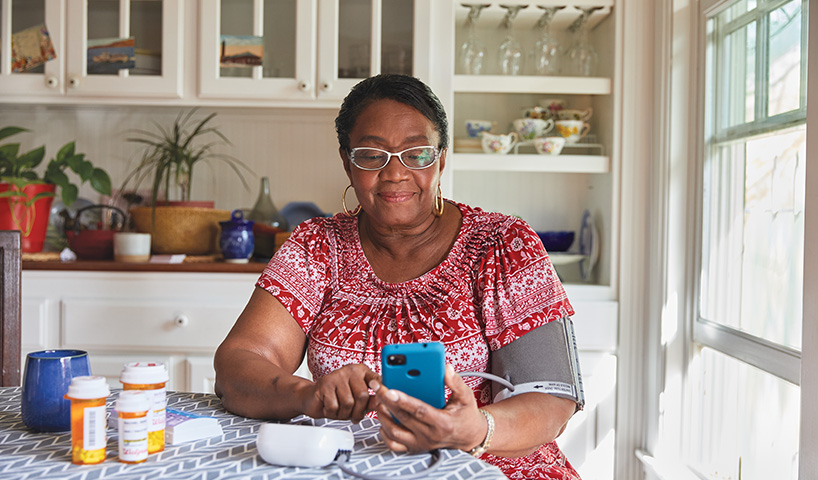
To address these obstacles, your organization can:
- Take SDOH into consideration to better support optimal outcomes in patient populations
- Help raise awareness for, and monitor progress toward, health equity
- Invest in and align with local community organizations that work to address SDOH for a positive effect on health outcomes
- Collaborate with community pharmacies such as Walgreens to ensure equitable access to care and information as well as leverage the strengths of each organization along the integrated patient healthcare journey
- Remove barriers to care, such as helping members navigate plan changes, to improve health outcomes
- Design and deliver plan documents and information in ways that are easily understood and accessible by all members
- Collect data and report on utilization by race, ethnicity, socioeconomic status and primary language
Advancing health equity requires your organization to:
- Embrace measures that integrate caring for the whole person, including incentivizing and driving value-based payment models with pharmacies, providers and health systems
- Prioritize measures that address total health and implement solutions to advance and monitor progress toward health equity
- Work with partners who prioritize total wellness and health equity
- Use and leverage community pharmacies as the convenient access point for many patients in underserved populations
- Educate and coach patients on the services and tools available, empowering them to better manage their health conditions and remain adherent to their medications
- Build provider, payor and patient relationships that go above and beyond to become the new standard for patient care
- Reduce the effect of chronic health conditions through integrated, holistic solutions and identifying at-risk patients for non-adherence
Partnering to achieve health equity
Walgreens Health offers a new care model to go beyond traditional care, working in tandem to bring equitable, personalized, whole-person healthcare to local communities across America, wherever and however best fits patient needs.
Working alongside payors and providers, Walgreens Health can create a better experience for patients, improve health outcomes and lower costs by leveraging Walgreens strengths and assets. Walgreens strengths include:
- Trusted consumer relationships
- Robust community and nationwide presence
- Expert pharmacy teams
- Valuable partnerships with payors and providers across the country
Our mission at Walgreens Health directly aligns to help you achieve your social responsibility goals and improve your members’ experience. We’re focusing on four key areas to drive meaningful impact:
- Social determinants of health
- Vaccination and testing
- Medication adherence & chronic care management
- Overall well-being focus and whole-person health
Together, we can make an intentional, focused effort to support all people on their healthcare journey, ensuring that vulnerable populations are not left behind.

